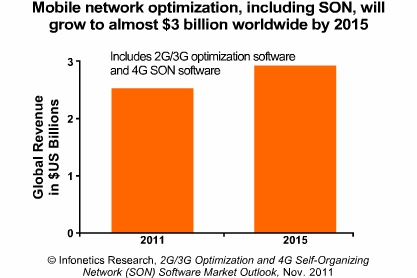2011年11月18日 CAMPBELL, California- 市場調査会社Infonetics Researchは本日、2G/3G Optimization and 4G Self-Organizing Network (SON) Software Market Outlook (2G/3G最適化技術と4G自己最適化ネットワーク (SON) ソフトウェア市場の展望)の抜粋を公開した。本レポートは最適化市場の調査を実質、初めて試みたものだ。本レポートでは、2Gと3Gの最適化ソフトウェアを含むモバイルネットワーク最適化 (MNO) 市場、および自動のLTEネットワークの開始に向けた4Gの自己最適化ネットワーク (SON) ソフトウェア市場の市場規模や予測を行なっている。

アナリストノート
このレポートの著者で、Infonetics Research のモバイルインフラの主任アナリストのStephane Teral氏は次のように述べている。「2Gと3Gのモバイルネットワークの最適化が登場して20年になる。その一方で、わずか10年前には非現実的な夢と思われたSONは2009年、ネットワークの運営タスクに人の手を必要としない「ゼロタッチネットワーク」形式として加わった。通信事業者が運用コストと設備投資の削減に急ぐ中、市場のどちらのセグメントも成長しているが、SONの急激な成長が今にも始まろうとしている。我々は2010年から2015年のSONソフトウェアの収益は、年平均成長率で84%になると予測しており、2G/3G最適化ソフトの収益は4%の成長を予想している。」
市場ハイライト
- 2G/3Gの最適化、および4GのSONソフトを含む、モバイルネットワーク最適化の市場は、2015年までに30億米ドル近くまで成長することが見込まれる。
- モバイル加入件数が引き続き2Gから3Gへ移行し、最終的には4Gに移行する中、ネットワークに効率性を求める通信事業者によって市場の成長が促されている。
- 2Gネットワークは世界のモバイル加入件数の78%を占め、残りは3Gとなっている。4Gネットワークは開始されたばかりである。
- 2G/3Gの最適化ソフトはMNO (モバイルネットワーク最適化) 市場全体の大部分を占めている。一方で、LTEネットワークの導入が進む中、SON (自己最適化ネットワーク) ソフトウェアは一番の成長を見せている。
- モバイルネットワーク最適化の市場では、通信事業者に販売するインフラに付加価値としてソフトウェアを付ける大規模な機器サプライヤーのため、小規模の専門ベンダーへの圧迫が増々強まっている。
- 2008年の中国の通信業界の再編以来、アジア太平洋地域はモバイルネットワーク最適化、およびSONの最大の市場である。
Infonetics' new 2G/3G Optimization and 4G Self-Organizing Network (SON) Software Market Outlook report provides worldwide and regional market size, revenue forecasts, and analysis of the mobile network optimization market, including 2G/3G optimization software and SON software. The report includes a mobile subscriber forecast (2G, 3G, 4G subscribers) snapshot, a Specialist Vendor Snapshot, a look at which SON features (such as automatic neighbor relations, or ANR) are most often implemented in LTE networks, and SON use cases that mobile operators foresee, from the Next Generation Mobile Networks Alliance.
The report tracks Tier 1 mobile infrastructure vendors with mobile network optimization tools, including Alcatel-Lucent, Ericsson, Huawei, Nokia Siemens Networks, and ZTE; as well as specialist vendors, including Actix, Aricent, Arieso, Ascom, Astellia, Axis Technologies, Bytemobile, Celtro, Commsquare, Eden Rock Communications, Infovista, InterDigital, Intucell, Mentum, Newfield Wireless, Plano Engineering, Reverb Networks, Schema, Symena, Theta Networks, TTG International, Tulinx, Vector, and Xceed Technologies.
RELATED RESEARCH
- Telecom capex up 6% to $311B in 2011, rev. up 8% to $1.86T, driven by mobile broadband
- Mobile VoIP subscribers will near 410 million by 2015; VoLTE still a long way off
- Infonetics ups VoIP services forecast to $76B in 2015, driven by SIP trunking, hosted business VoIP
Mobile network optimization / self-organizing network (SON) market nearing $3B by 2015
CAMPBELL, California, Nov. 18, 2011-Market research firm Infonetics Research today released a new 2G/3G Optimization and 4G Self-Organizing Network (SON) Software Market Outlook, the industry's first realistic attempt to size the optimization market. The report sizes and forecasts the mobile network optimization (MNO) market, including 2G and 3G optimization software and 4G self-organizing network (SON) software aimed at automating LTE network rollouts.
ANALYST NOTE
"While 2G and 3G mobile network optimization has been around for two decades, SON -- considered an unrealistic dream just 10 years ago -- is new to the party as of 2009 as the first iteration of the 'zero-touch' network, diminishing human involvement in network operational tasks. Both segments of the market are growing as telecom operators race to reduce their opex and capex, but SON is about to skyrocket: we forecast global SON software revenue to grow at an 84% CAGR from 2010 to 2015, and 2G/3G optimization software revenue to grow at 4%," notes Stephane Teral, author of the report and principal analyst for mobile infrastructure at Infonetics Research.
MARKET HIGHLIGHTS
- The mobile network optimization market, including 2G/3G optimization and 4G SON software, is forecast to grow to almost US$3.0 billion by 2015
- The market is being fueled by telecom operators seeking efficiencies in their networks as mobile subscribers continue migrating from 2G to 3G technology, and eventually to 4G
- 78% of the world's mobile subscribers are on 2G networks, the rest are on 3G, with 4G networks just getting started
- 2G/3G optimization software makes up the majority of the overall MNO market, while SON software is growing the fastest, driven by growing LTE network rollouts
- Smaller specialist vendors in the mobile network optimization market are being increasingly squeezed by larger equipment suppliers happy to throw in software as a value-add to the infrastructure they sell to telecom operators
- Since the restructuring of China's telecommunications industry in 2008, Asia Pacific has become the largest market for mobile network optimization and SON

